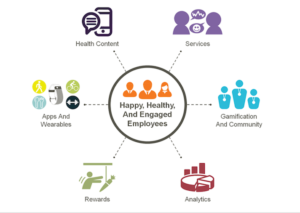Contents
- 1 Employee Wellbeing In The Workplace & Its Benefits
- 2 What Is Employee Wellbeing?
- 3 How To Implement A Wellness Program?
- 4 Framework To Begin The Program
- 5 How Does Your Company Promote Employee Wellbeing?
- 6 Benefits Of Employee Wellbeing For An Organization
- 7 Challenges Of Implementing An Employee Wellbeing Program
- 8 A Word From Mantra care
Employee Wellbeing In The Workplace & Its Benefits

Many companies are now taking their employees’ well-being into consideration when making decisions. There are different ways that employee wellbeing is being taken into consideration, such as providing adequate breaks and even changing the time of day in which certain work tasks are performed. For example, some companies provide naps to their employees during the day or provide nighttime workers with high-intensity light therapy to help them sleep better at night. There are a number of different wellness initiatives that have been implemented by various organizations to promote employee wellbeing and it’s something you should explore if you’re looking for new options.
The concept of employee wellbeing is not new. It has been around for decades, but it wasn’t until recently that companies started to take notice and implement programs to help their employees be happier at work. There are many different ways in which the well-being of employees can be improved, such as providing adequate breaks or changing when certain tasks are completed so that they’re more aligned with an individual’s natural circadian rhythm. For example, some companies provide naps during the day or use high-intensity light therapy at night to help those who work overnight sleep better. This article will explore how you can promote your own employee wellness program in order to improve your company culture and attract top talent.
What Is Employee Wellbeing?

Employee wellbeing is the idea that employers are taking into consideration in order to improve the happiness of their employees. There are many different points that an employer can consider in order to promote employee wellbeing, such as providing adequate time for breaks or changing when certain tasks are completed so they align with an individual’s natural circadian rhythm.
For example, some companies provide naps during the day or use high-intensity light therapy at night to help those who work overnight sleep better.
There are many different examples of how an employer can promote employee wellness. For instance, some companies provide naps during the day or use high-intensity light therapy at night to help those who work overnight sleep better. This article will explore how you can implement a wellness program in the workplace to help attract talented employees.
Employee wellbeing has been around for decades, but it wasn’t until recently that companies started to implement programs to increase the happiness of their employees at work. This is a relatively new concept and there are many points that an employer can consider in order to promote employee wellbeing, example include providing adequate time for breaks or changing when certain tasks are completed so they align with an individual’s natural circadian rhythm.
How To Implement A Wellness Program?

Companies have started to implement different programs in order to increase the happiness of their employees at work. Some companies provide naps during the day or use high-intensity light therapy at night to help those who work overnight sleep better. This article will explore how you can implement a wellness program in your workplace that could attract talented employees.
The first step to starting a wellness program in your workplace is figuring out what the goals of the program will be. To do this, you can consult employees at your company and see what they want from such a program. A new study shows that some ideas include:
- Implementing yoga or stretching classes during lunch breaks: Implementing yoga or stretching classes at lunchtime for one month. Generating feedback from employees about their experience with yoga or stretching at lunchtime.
- Offering mental health days: Offering mental health days for one month. Generating feedback from employees about their experience with mental health days.
- Bringing in therapists on site: Bringing in various guest speakers to talk about their stories and advice could also be an option if the company is looking to increase wellness. Many universities do this as well, so it could be beneficial to look into this idea further before starting the program. This would give employees a chance to learn from others who have overcome challenges that they are currently facing.
- Allowing flexible work schedules
Framework To Begin The Program
 The Employee Wellbeing team should produce a framework to begin the program and present this to their fellow employees. This framework will include:
The Employee Wellbeing team should produce a framework to begin the program and present this to their fellow employees. This framework will include:
- Goals and objectives of the wellness program
- Objectives for how you will be implementing programs in each department
- Options for different wellness programs (e.g. gym memberships)
Before starting with this process, it is important to decide on how many people are representing each department. Because this will ensure all departments are participating equally. Each person should be looking at what kind of challenges they face when coming into work. Or while working with certain kinds of individuals. After brainstorming these challenges over lunchtime meetings over a few weeks. You can them towards the fitness initiatives that could help with stress.
For example, if your organization is full of introverts who have a hard time dealing with conflict on certain projects. Then you could suggest mindfulness meditation courses or yoga classes help them develop coping mechanisms before they come into work. This would be an initiative that the wellness team can target introverted employees. Because it will help increase their well-being at work. Furthermore, since some people are more introverted, this will help create a healthy space for those individuals who need to recharge after stressful situations or during project crunch times.
Moving forward, the framework created by the employee wellbeing team should be presented and implemented across all departments in order to make sure everyone is practicing these programs and using the resources provided. Employees should feel like they belong in this culture of wellbeing.
How Does Your Company Promote Employee Wellbeing?

After doing some research on these ideas, you should test them out and see if they will actually improve employee wellbeing. Some steps for testing could be:
Once you have finished implementing these programs. Ask employees how they felt after doing yoga or stretching classes, how they felt after taking off work for mental health days, or what their experiences were like when listening to guest speakers share their stories. This data will be extremely beneficial when writing a summary of the program. And deciding whether or not to continue with it.
After collecting all the feedback, you should create a team to plan out your wellness program. The people working on this program could include:
- A supervisor (or any other leader in the company)
- An HR member that specializes in wellness initiatives
- Employee relations representative (possibly an external consultant)
The purpose of this team is to make sure your employees reach their fullest potential while at work by promoting interactions between each other and encouraging them to stay healthy and happy throughout their careers.
Benefits Of Employee Wellbeing For An Organization

Employee wellbeing has been long neglected by organizations which has caused to be left behind in productivity, engagement, and satisfaction. Organizations have started to implement different programs in order to increase the happiness of their employees at work. Some companies provide naps during the day or use high-intensity light therapy at night. To help those who work overnight sleep better. There are many benefits for employers when implementing a wellness program in their workplace.
Employee wellbeing is an area of concern for companies as poor mental and physical health. It can lead to increased absenteeism, higher staff turnover, and low engagement, affecting productivity and profitability. Despite this, around 85% of companies in Australia do not have a wellness program in place. And only 20% offer any kind of counseling service. Employers need to focus on employee wellbeing and highlight some initiatives that could be used within different industries. To enhance employees’ lives both inside and outside the workplace.
Increased Productivity
One of the main benefits is increased productivity which comes from happier employees working for longer periods of time each day. When employees are happy they are more likely to want to come into work. And be more productive compared with when they don’t enjoy coming into work. Through employee wellbeing programs, an employer can create a cohesive culture where people are maintaining a healthy lifestyle while enjoying the work they do. This is beneficial for employers because happy employees attract talent, boost resilience and increase retention rates.
Increased Engagement
Another benefit from increased employee wellbeing is increased engagement between employees at work. Happiness, confidence, and relaxation all have been linked to improving our relationships with others in a positive manner. Having wellness environment in a workplace can create a better working culture. Especially among employees who feel supported by each other when going through difficult times. It can also lead to job satisfaction because employees will focus on the task at hand. Rather than worrying about what is going on in their personal lives. That could affect how they perform their job duties.
High Employee Retainment
Employee wellbeing has benefits for organizations. Through employee programs, an employer can create a cohesive culture where people are working towards their short and long-term goals while enjoying their work. These benefits include increased productivity, engagement between employees at work, and job satisfaction. Organizations started implementing these programs in order to make happy employees who become more productive the longer they stay at their jobs. There are many benefits for employers when implementing wellbeing initiatives in workplaces. That could make them an essential part of the overall business strategy.
Healthy Lifestyle
Working towards a healthy lifestyle and having support from your employer can benefit both the individual and the organization. There are many different kinds of initiatives and activities that can be helpful in maintaining well-being within the workplace. And to encourage best practices for healthy living while working at an organization.
Healthy Eating Options On Campus

Many organizations will offer on-site cafeterias with meal plans or vending machines that contain healthier food options. Such as fresh fruit, salads, sandwiches/wraps, yogurt parfaits, etc. This will limit the number of unhealthy food choices available which could help employees avoid poor food choices through convenience. Companies may also set up lunchtime running groups or hire a personal trainer to teach some of the employees how to use the equipment effectively.
These kinds of initiatives can impact the physical health of employees as well as their mental wellbeing by providing healthy food choices. When they’re available and creating a fun environment where everyone is trying to reach common goals.
Increased Physical Activity
Some companies will hire personal trainers, set up exercise rooms or gym memberships that are included in an individual’s salary. This will provide them with opportunities for strength training, cardiovascular workouts, martial arts classes, yoga sessions, etc. These activities can help increase overall energy levels while making people feel more confident in their abilities both at work and out in public. People who exercise regularly also tend to eat healthier which could reduce obesity rates within an organization. So it becomes easier for them to focus on their jobs instead of their health.
Professional Care
A lot of organizations will provide employees with EAPs that involve access to professional counseling services. That can help if there are any issues that come up where employees need outside perspective or advice. This could include personal counseling, mental health consultations, financial advice, etc. These kinds of programs can help increase well-being because they offer employees opportunities for one-on-one sessions. By professionals who have the right tools and knowledge needed to assist them in overcoming different challenges. That they may face at work or in private life.
Challenges Of Implementing An Employee Wellbeing Program

Before implementing any kind of wellness initiative within your organization. It is important to assess what kind of barriers people are facing when coming into work every day. There may be certain groups of people who feel as though these types of activities might not be for them. And this can make it difficult to get everyone on board and committed to the changes that need to take place.
Once you have a better understanding of what problems or challenges employees are facing. Brainstorming ways to solve those issues should be the next step in order to provide support to improve their overall wellbeing.
The importance of employee wellbeing at work cannot be neglected. For many people, their jobs are the most important thing in their lives. And if they don’t feel valued or supported where it can have a negative impact on all aspects of their life personal health included. The best way to promote wellness programs is by involving employees in the process from start to finish. So that everyone feels like they matter. If you want help implementing these types of initiatives into your organization. But aren’t sure where to start, let our team know. We’ve done this before for other organizations with great success. So we would like to partner with you on creating an inclusive environment for all employees that promote healthy living. Both inside and outside of the workplace.
A Word From Mantra care
Do you want to keep your employees happy, healthy, and productive? Join our employee assistance program and get a healthier workplace.


